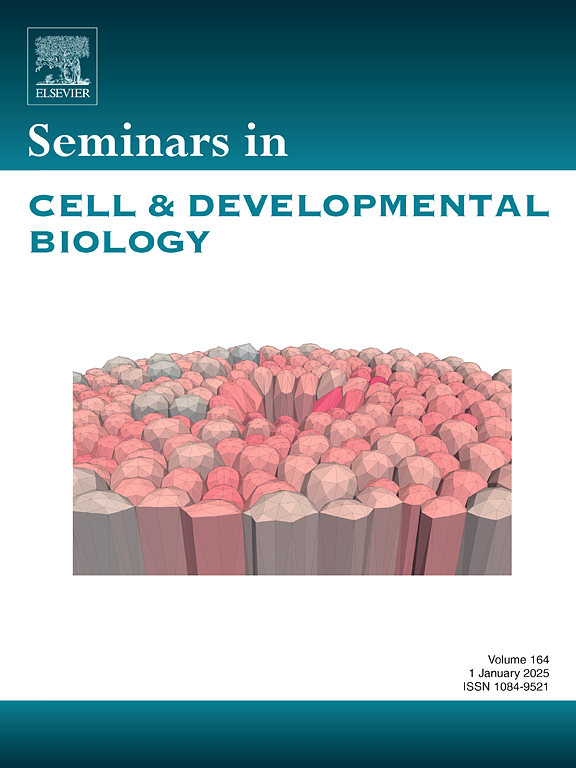卵发生机制:秀丽隐杆线虫种系囊肿的教训
IF 6
2区 生物学
Q1 CELL BIOLOGY
引用次数: 0
摘要
生殖细胞被组织成合胞体结构,其中单个细胞通过细胞间桥保持连接。在这种被称为生殖系囊肿的结构框架中,一部分生殖细胞扩大并发育成卵母细胞,而其他生殖细胞则缩小并因细胞死亡而消失。最近对秀丽隐杆线虫的研究表明,凋亡介导的生殖细胞死亡和存活生殖细胞的扩大都受机械力的调节。生殖细胞表现出由肌动球蛋白收缩性驱动的体积随机波动。由于囊肿内流体静压差异驱动的机械不稳定性,这种初始大小的异质性逐渐扩大,使较小的细胞倾向于收缩和随后的凋亡死亡。RAS/MAPK信号级联和ECT-2/RhoA通路进一步加强了这种机械不稳定性,两者都增强了肌动球蛋白的收缩性。存活的生殖细胞通过肌动球蛋白收缩介导的囊内流体动力流动获取细胞质物质,继续生长。总的来说,这些发现强调了机械力在调节细胞生存和死亡之间的命运决定、促进细胞体积动力学和维持卵子发生期间种系稳态方面的关键作用。本文章由计算机程序翻译,如有差异,请以英文原文为准。
Mechanics of oogenesis: Lessons from C. elegans germline cysts
Germ cells are organized into a syncytial architecture, wherein individual cells remain connected via intercellular bridges. Within this structural framework, known as germline cysts, a subset of germ cells enlarges and develops into oocytes, while others shrink and are eliminated through cell death. Recent studies with Caenorhabditis elegans have revealed that both apoptosis-mediated germ cell death and enlargement of surviving germ cells are regulated by mechanical forces. Germ cells exhibit stochastic fluctuations in volume driven by actomyosin contractility. This initial size heterogeneity is progressively amplified due to mechanical instability driven by differential hydrostatic pressure within the cyst, which biases smaller cells toward shrinkage and subsequent apoptotic death. This mechanical instability is further reinforced by the RAS/MAPK signaling cascade and the ECT-2/RhoA pathway, both of which enhance actomyosin contractility. Surviving germ cells continue to grow by acquiring the cytoplasmic materials through actomyosin contractility-mediated hydrodynamic flow within the cyst. Collectively, these findings highlight the critical role of mechanical forces in modulating cell fate decisions between survival and death, facilitating cell volume dynamics and maintaining germline homeostasis during oogenesis.
求助全文
通过发布文献求助,成功后即可免费获取论文全文。
去求助
来源期刊
CiteScore
15.10
自引率
1.40%
发文量
310
审稿时长
9.1 weeks
期刊介绍:
Seminars in Cell and Developmental Biology is a review journal dedicated to keeping scientists informed of developments in the field of molecular cell and developmental biology, on a topic by topic basis. Each issue is thematic in approach, devoted to an important topic of interest to cell and developmental biologists, focusing on the latest advances and their specific implications.
The aim of each issue is to provide a coordinated, readable, and lively review of a selected area, published rapidly to ensure currency.

 求助内容:
求助内容: 应助结果提醒方式:
应助结果提醒方式:


